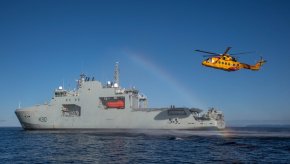I am not a naval engineer but with the weights creeping up is the installed power enough to keep up with a Carrier Strike Group? I see installed power of 40MW on the Turbine, and 12MW on the Gensets for something along the lines of 52MW total output. The Type 45's look to have a similar output but something like a Flight I Arleigh Burke is closer to 75MW.
Weights of warships are always subjective & CSC/T26/Hunter will be no different. WEIGHT effects the distance the ship can travel, more than the top speed element.
For instance, when LCS was on paper they wanted a ship that could travel from San Diego to Hawaii, without refuelling, while maintaining a 'specific' speed. By the time the 1st ship hit the water, returned from testing & had some of the structural elements 'fixed' (
due to the hull form degrading because of the effects of speed thru water on aluminium), the 'fix' had added something like between 15 & 30 tonnes to the overall weight of the ship. This compounded by other design & equipment issues, meant that once the Naval architects / boffins had used their slide rules to calculate everything, it was apparent that the LCS would run out of fuel, before she ever reached port.
The hull form design
(physical shape), balance fore to aft (
whether the ship is tail heavy/bow light,), affects the 'portion' of the hull in the water, elements causing drag in the water (
including the hull coating itself), can contribute to a vessel being technically limited to being able to reach speeds over 25 Kts
While CBG's like to keep a 'top speed, it is usually closer to 20 Kts, to accommodate 'slower vessels', such a fuel tankers & logistics support ships. Power generation is also to do with the equipment used on the hull for weapons, etc., so an overall electrical load of the platform to power radars / trackers & communications systems drive up the 'need' for larger MW engines. Building in 'future-proofing' to do this (
i.e. to accommodate directed energy weapons / rail guns), means it is better to have so 'spare in the tank', so to speak. Finally, as ships age the do inevitably get heavier (layers of paint /additional cabling/pipework/ducting systems, etc., etc, all add up), so building in 'reserve' to account for this, is always a good thing.
SA





